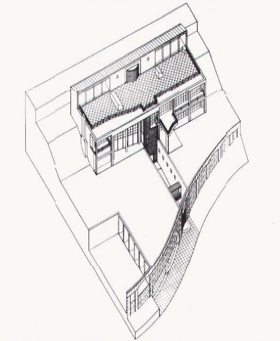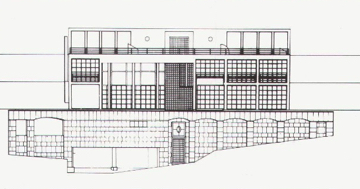Also notable about the underlying eclectic marauding of Seligmann’s brand of architecture is that there is no singular emphatic regimen, as one tends to find in the works of many of the most familiar architects of the twentieth century, architects who either played out the doctrinal catechisms of functionalism or rationalism or organicism, or of a singular “brand” identity, or of all the “post-”s and “neo-”s that ensued. One thinks instead of Picasso’s defense of his “borrowing” from the paintings of Braque and others: it liberated him from stylistic concerns so that he might be able to concentrate on the essential art of painting. Similarly, for Seligmann, architecture was never seen as the occasion for radical polemicizing, but instead as the opportunity for rediscovering the intrinsic humanism of architectural space, especially as it was configured and reconfigured throughout history.
While the details of his biography are difficult to penetrate, and psychologizing is rarely done well, it's probably safe to say that Werner Seligmann had no fondness for the dictatorial, monological voice. Certainly, buildings that presented themselves as adherents of a singular authority, or as manifestations of a single idea—buildings he described as “one-liners”—were rarely discussed in Seligmann's lectures and writings, other than disparagingly. Because of the presence of the whispers of other architectures, Seligmann’s own architecture was never a monologue, it never "spoke" with a singular voice.
Again, regarding Campi-Pessina and the "Tendenza" of southern Switzerland, Seligmann cannot resist pointing out their baroque—and Italian—heritage:
"While the architects of this region declare themselves Swiss, their stronger spiritual, intellectual, and architectural ties are to Italy. They take pride in an architectural heritage that includes, they point out, three of the most significant architects of the Italian Baroque, all born in the region of Lugano: Domenico Fontana, Carlo Maderno, and Francesco Borromini."
At the same time, the simple duplication of a model or even the direct adoption of a type is to be avoided:
"What distinguishes the solution [of Campi-Pessina-Piazzoli's Felder House] is the way in which the architectural characteristics of the existing building [on the same site, a turn-of the-century villa] are accepted, and reinterpreted, thus creating a purer version of the same type."
Of course, this means that in order to teach design, one must also teach the history and the theory of design, another idea highly reminiscent of Moretti’s philosophy behind the establishment of Spazio. Again, in his Topaz Medallion speech, Seligmann said:
"At the basis of the teaching [of core studies in architecture] lies the assumption that architecture is a formal construct and that it operates through its own particular logic. It is this architectural logic which would constitute the intellectual framework for the core, which means that the success of the core model depends on a parallel teaching of history and theory. By theory, however, I mean perhaps something else than is commonly understood—a theoretical discourse appropriate to the student’s stage in design, such as the properties of architectural space, of parti, the formal logic and the appropriate arrangement of a plan, etc.—not exactly hot, current topics."
Introduction page 10


Fig 12a, b Campi Pessina Piazzoli: Boni House, Massagno, 1981. Seligmann points out the intrinsic eclecticism of the precedents that this house brings to mind: the Villa dei Vescovi of Giovanni Falconetto, the Villa Medici of Carreto Guidi of Bernardo Buontalenti, and Giuseppe Terragni’s Casa del Fascio in Como.